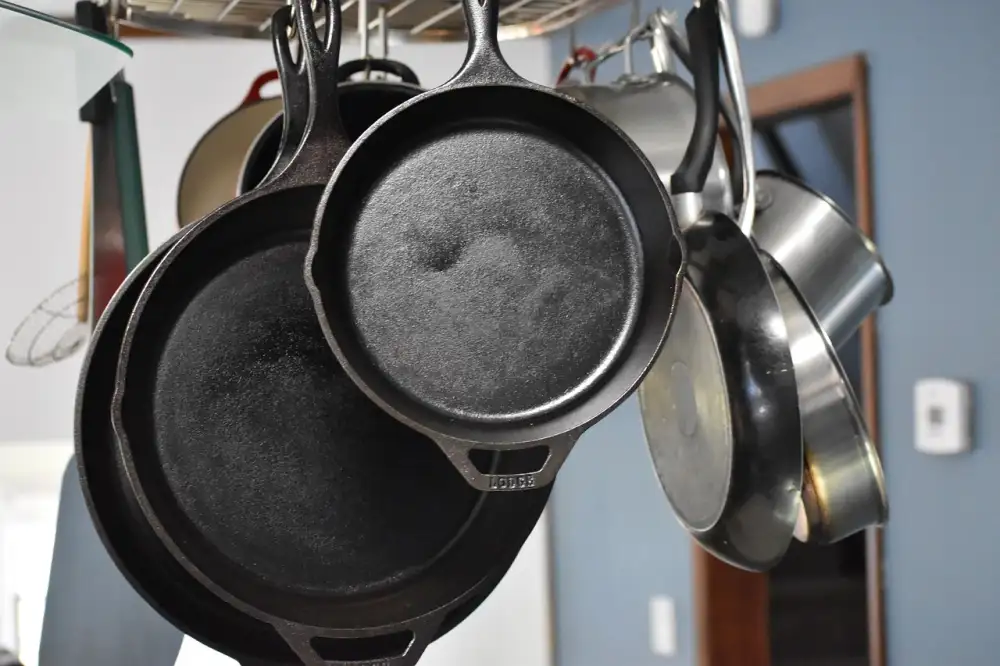Ultimate Guide: How to Properly Clean a Cast Iron Skillet at Home

- Gather necessary supplies: coarse salt, a sponge or brush, dish soap, a towel, and vegetable oil.
- Rinse the skillet with hot water while it's still warm.
- Sprinkle coarse salt on the skillet to act as a gentle abrasive.
- Use a sponge or brush to scrub the skillet, focusing on any stubborn food residue.
- Rinse the skillet thoroughly with hot water.
- Dry the skillet completely using a towel.
- Place the skillet on the stove over low heat to ensure it's completely dry.
- Once dry, apply a thin layer of vegetable oil to the skillet to prevent rust.
- Store the skillet in a dry place until next use.
Gather necessary supplies: coarse salt, a sponge or brush, dish soap, a towel, and vegetable oil.
To properly clean a cast iron skillet at home, it's essential to gather the necessary supplies beforehand. You will need coarse salt, which acts as a gentle abrasive for scrubbing, a sponge or brush to help remove food residue, dish soap for cleaning, a towel for drying, and vegetable oil to prevent rusting. Having these items on hand will ensure that you can effectively clean and maintain your cast iron skillet for long-lasting use.
Rinse the skillet with hot water while it's still warm.
Rinsing the skillet with hot water while it's still warm is a crucial step in properly cleaning a cast iron skillet. This process helps to loosen any stuck-on food particles and makes them easier to remove. The heat from the warm skillet also aids in evaporating excess moisture, which can help prevent rusting. Be sure to use hot water, as cold water can shock the cast iron and potentially cause damage. By rinsing the skillet promptly after use, you'll set yourself up for success in maintaining its quality for years to come.
Sprinkle coarse salt on the skillet to act as a gentle abrasive.
Sprinkling coarse salt on the skillet is a key step in properly cleaning it. The coarse salt acts as a gentle abrasive that helps to loosen any stuck-on food particles without damaging the skillet's seasoning. This method is effective in removing stubborn residue while being gentle enough to preserve the skillet's non-stick surface. By sprinkling a generous amount of salt and using a sponge or brush to scrub, you can ensure that your cast iron skillet remains clean and well-maintained for future use.
Use a sponge or brush to scrub the skillet, focusing on any stubborn food residue.
To effectively clean a cast iron skillet, use a sponge or brush to scrub the surface, paying special attention to any stubborn food residue. The coarse salt acts as a gentle abrasive to help lift off any stuck-on bits without damaging the skillet's seasoning. Gently scrub in circular motions, ensuring all areas are thoroughly cleaned. This step is crucial for maintaining the skillet's non-stick surface and preventing any leftover food from affecting the flavor of future dishes cooked in it.
Rinse the skillet thoroughly with hot water.
After scrubbing the skillet with salt, it's essential to rinse it thoroughly with hot water. This step helps to remove any remaining food particles and salt residue from the skillet's surface. Make sure to use hot water as it helps to loosen any stuck-on bits of food and aids in the cleaning process. Thorough rinsing is crucial to ensure that the skillet is clean and ready for drying.
Dry the skillet completely using a towel.
After rinsing the skillet thoroughly with hot water, it's crucial to dry it completely using a towel. Any remaining moisture left on the skillet can lead to rusting over time. Make sure to use a clean and dry towel to remove all traces of water from the surface of the skillet. Pay special attention to drying the handle and any crevices where water might accumulate. Properly drying the skillet will help maintain its seasoning and prevent any potential damage.
Place the skillet on the stove over low heat to ensure it's completely dry.
After drying the skillet with a towel, it's essential to ensure that it's completely dry before storing it. To achieve this, place the skillet on the stove over low heat for a few minutes. This process helps to evaporate any remaining moisture, preventing rust from forming on the cast iron surface. Make sure to keep an eye on it to avoid overheating. Once you're certain the skillet is dry, proceed to the next step of applying a thin layer of vegetable oil for protection against rust.
Once dry, apply a thin layer of vegetable oil to the skillet to prevent rust.
Once the skillet is completely dry, it's important to prevent rust by applying a thin layer of vegetable oil. This process helps to create a protective barrier on the surface of the cast iron, keeping it in good condition for future use. The oil also helps to maintain the skillet's seasoning, enhancing its non-stick properties over time. Be sure to use a paper towel or cloth to evenly coat the entire skillet with a light layer of vegetable oil before storing it in a dry place until its next use.
Store the skillet in a dry place until next use.
After properly cleaning and seasoning your cast iron skillet, it's important to store it correctly to maintain its quality. Once the skillet is completely dry and seasoned with a thin layer of vegetable oil, store it in a dry place until its next use. Avoid stacking other cookware on top of the skillet to prevent any potential damage or moisture buildup. A good option is to place a paper towel inside the skillet to absorb any excess moisture and prevent rusting. By storing your cast iron skillet in a dry environment, you'll ensure it stays in excellent condition for many years of delicious cooking ahead.
Published: 21. 04. 2024
Category: Home



